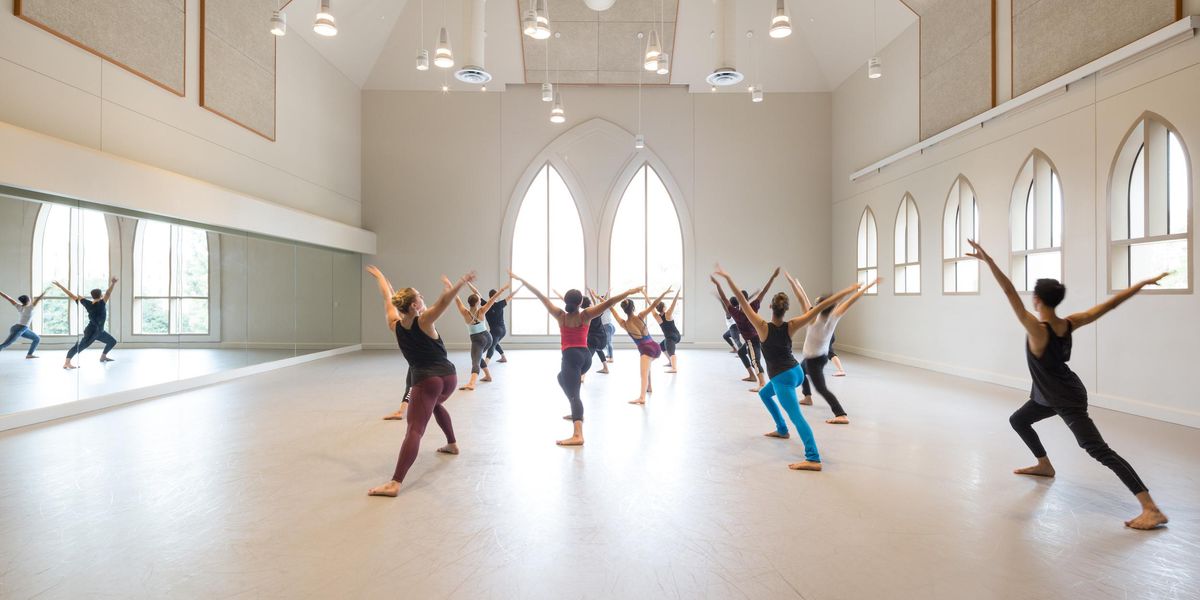Your Body: Sit Down
Lydia Hance’s supple spine and high-volume dancing are evident in Context, her latest work, which combines dynamic curves with highly defined shapes. Hance, artistic director of Houston-based Frame Dance Productions, attributes her flexibility to regular Gyrokinesis classes.
Many dancers find they benefit from Gyrokinesis. It was created by Juliu Horvath, who also devised the Gyrotonic system. While Gyrotonic uses equipment to build strength and flexibility, Gyrokinesis focuses on the articulation of the spine, and all you need is a stool and a mat. Both are conditioning systems that start with tiny movements designed to wake the body up and progress to larger, more energetic exercises, delivering a thorough warm-up over 60 to 90 minutes.
Anjali Austin finds that her students at Florida State University benefit from her Gyrokinesis classes on several levels. “Gyrokinesis was developed with the special needs of a dancer in mind,” says Austin, a former member of Dance Theatre of Harlem. “The rhythmic and circular quality of the work, along with attention to breathing, really speaks to dancers.” The curling, arching, and twisting exercises are movements found in contemporary choreography. The more a dancer can articulate her spine, the more the spine can act as a shock absorber, protecting the lower body. This leads to greater freedom in the hips, hamstrings, and lower back.
Dancers rarely get a chance to focus on their spinal articulation free of the heavy work of the legs. “The dancers sit on a stool. That allows them to get off their legs and focus on their spinal mobility, warming up from the inside out,” says Austin.
Doing Gyrokinesis before class prepares the body for the day. “It’s a physical and mental warm-up, so by the time the students are in class they are ready to take risks,” says Austin. “Because Gyrokinesis activates weaker muscles, dancers learn to work more efficiently and economically.” Gyrokinesis classes begin with an inward focus in a form of self-massage. “This is a time to check in and sense from within what our bodies need,” says Austin. The exercises then progress in rigor and intensity, until the dancer is finally working her body completely.
Two typical Gyrokinesis exercises, “Percussion” and “Arch and Curl,” represent both that awakening and the more rigorous segments that follow it.
Percussion:
This series of small exercises stimulates the organs and encourages healthy function. Sit on a stool with hips slightly higher than the knees. Begin brushing the chest with your hand in a downward motion over the heart. The brushing action should have enough pressure to feel the body rebound or bounce back after each contact. Next, attention shifts to similar massaging movement on the rib cage and solar plexus. Use the tips of the fingers to tap the rib cage area. The amount of pressure remains the same as the first movement, with the fingers bouncing off of the body. After a few taps, the tapping moves lower to the abdomen and below the belly button.
Arch and Curl:
Sit on a stool with hips slightly higher than the knees, with the knees bent and feet flat on the floor and hands on thighs. Begin by reaching the chest forward with the sternum lifting up toward the ceiling as the tailbone lengthens back (look diagonally upward). Keep the back of the neck directly over the tailbone. To curl, bring the belly button towards the backbone, carve out the abdominals and soften the sternum as the lower back lengthens to the wall behind (look diagonally downward). Shoulders remain over the hips when working both directions.
Nancy Wozny writes about health and the arts from Houston.
Photo courtesy gyrotonic.com.
Seeing Red
Beets pack a punch when it comes to nutrition. This deep-red root veggie is full of phytonutrients that provide antioxidant, anti-inflammatory, and detoxification qualities—all benefits that protect dancers during the rigors of an intense season. They are also a source of two carotenoids that are crucial to eye health: lutein and zeaxanthin. Enjoy beets pickled in a jar, freshly grated in your salad, or roasted in the oven. Oh, and The New York Times has pronounced them the new spinach.
Your Own Personal Pilates App
Need a little Pilates on the go? Dance writer and Pilates teacher Christie Taylor Seaver, owner of D4 Pilates in Dublin, has created the Pocket Pilates iPhone app. With Seaver’s handy text and audio instruction, Pilates is just a thumb click away. The moves have been tailored for wherever you happen to find yourself—waiting for a train, stuck at the office, at home, or on vacation. The Pocket Pilates iPhone app, at only $1.99, is available at the Apple app store.
Photos from istock.




